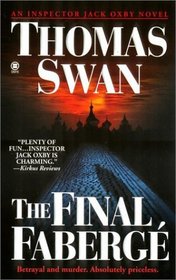I have a weakness for the beauty and brutality of Tsarist Russian history, especially in the fields of art and architecture. Combine that with a love of art history mysteries like Iain Pears' Jonathan Argyll series, and it was inevitable that I would read Thomas Swan's The Final Fabergé.
Scotland Yard art crime detective Jack Oxby has figured in two other books by Swan. He's been in this division of the Yard for fifteen years. He's savvy, he's got all sorts of contacts he can ask for help, and he's more than willing to jump on a plane and fly to who-knows-where in order to track down information.
From a promising beginning, The Final Fabergé rapidly devolved into a standard thriller: dashing from one location to the next to showcase Oxby's expertise in dodging bullets and knives while learning about power-hungry baddies and soulless henchmen. While not bad by any stretch of the imagination, the book would have been improved by spending more time in the historical aspect of the story-- in Fabergé's workshop and in the houses of the rich and titled. So much time was spent in chases and ambushes that it was easy to forget-- or to really understand-- what all the commotion was about. Yes, I would have loved to have spent more time immersed in the mystique of Fabergé and the treasures he and his artists created.
Will I be looking to meet Jack Oxby again? I rather doubt it.
Scotland Yard art crime detective Jack Oxby has figured in two other books by Swan. He's been in this division of the Yard for fifteen years. He's savvy, he's got all sorts of contacts he can ask for help, and he's more than willing to jump on a plane and fly to who-knows-where in order to track down information.
From a promising beginning, The Final Fabergé rapidly devolved into a standard thriller: dashing from one location to the next to showcase Oxby's expertise in dodging bullets and knives while learning about power-hungry baddies and soulless henchmen. While not bad by any stretch of the imagination, the book would have been improved by spending more time in the historical aspect of the story-- in Fabergé's workshop and in the houses of the rich and titled. So much time was spent in chases and ambushes that it was easy to forget-- or to really understand-- what all the commotion was about. Yes, I would have loved to have spent more time immersed in the mystique of Fabergé and the treasures he and his artists created.
Will I be looking to meet Jack Oxby again? I rather doubt it.




